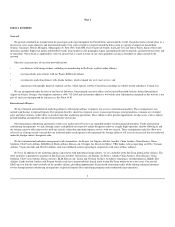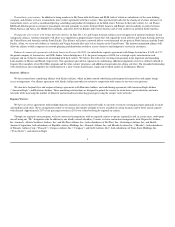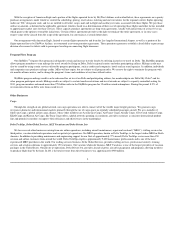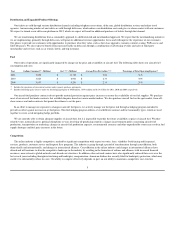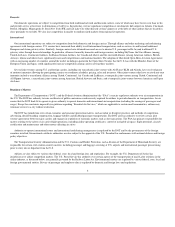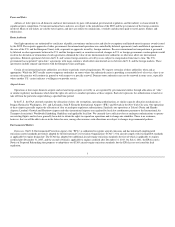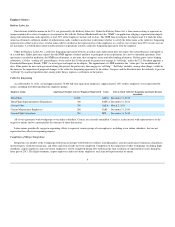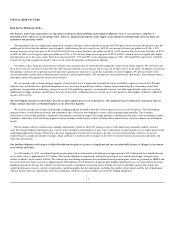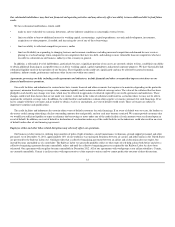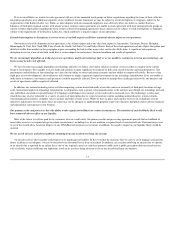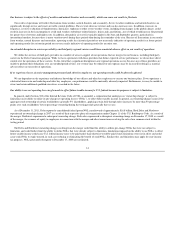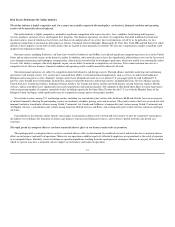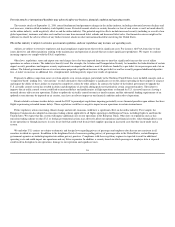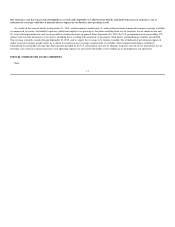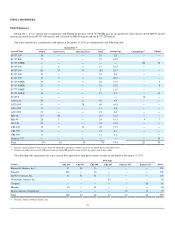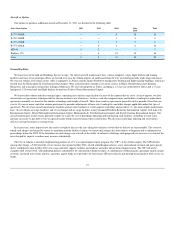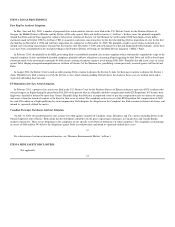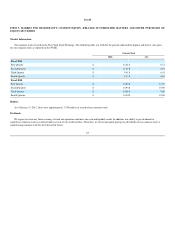Delta Airlines 2011 Annual Report Download - page 18
Download and view the complete annual report
Please find page 18 of the 2011 Delta Airlines annual report below. You can navigate through the pages in the report by either clicking on the pages listed below, or by using the keyword search tool below to find specific information within the annual report.
Our substantial indebtedness may limit our financial and operating activities and may adversely affect our ability to incur additional debt to fund future
needs.
We have substantial indebtedness, which could:
• make us more vulnerable to economic downturns, adverse industry conditions or catastrophic external events;
• limit our ability to borrow additional money for working capital, restructurings, capital expenditures, research and development, investments,
acquisitions or other purposes, if needed, and increasing the cost of any of these borrowings;
• limit our ability to withstand competitive pressures; and/or
• limit our flexibility in responding to changing business and economic conditions, including increased competition and demand for new services,
placing us at a disadvantage when compared to our competitors that have less debt, and making us more vulnerable than our competitors who have
less debt to a downturn in our business, industry or the economy in general.
In addition, a substantial level of indebtedness, particularly because a significant portion of our assets are currently subject to liens, could limit our ability
to obtain additional financing on acceptable terms or at all for working capital, capital expenditures and general corporate purposes. We have historically had
substantial liquidity needs in the operation of our business. These liquidity needs could vary significantly and may be affected by general economic
conditions, industry trends, performance and many other factors not within our control.
Agreements governing our debt, including credit agreements and indentures, include financial and other covenants that impose restrictions on our
financial and business operations.
Our credit facilities and indentures for secured notes have various financial and other covenants that require us to maintain, depending on the particular
agreement, minimum fixed charge coverage ratios, minimum liquidity and/or minimum collateral coverage ratios. The value of the collateral that has been
pledged in each facility may change over time, which may be reflected in appraisals of collateral required by our credit agreements and indentures. These
changes could result from factors that are not under our control. A decline in the value of collateral could result in a situation where we may not be able to
maintain the collateral coverage ratio. In addition, the credit facilities and indentures contain other negative covenants customary for such financings. If we
fail to comply with these covenants and are unable to obtain a waiver or amendment, an event of default would result. These covenants are subject to
important exceptions and qualifications.
The credit facilities and indentures also contain other events of default customary for such financings. If an event of default were to occur, the lenders or
the trustee could, among other things, declare outstanding amounts due and payable, and our cash may become restricted. We cannot provide assurance that
we would have sufficient liquidity to repay or refinance the borrowings or notes under any of the credit facilities if such amounts were accelerated upon an
event of default. In addition, an event of default or declaration of acceleration under any of the credit facilities or the indentures could also result in an event
of default under other of our financing agreements.
Employee strikes and other labor-related disruptions may adversely affect our operations.
Our business is labor intensive, utilizing large numbers of pilots, flight attendants, aircraft maintenance technicians, ground support personnel and other
personnel. As of December 31, 2011, approximately 16% of our workforce was unionized. Relations between air carriers and labor unions in the United States
are governed by the Railway Labor Act, which provides that a collective bargaining agreement between an airline and a labor union does not expire, but
instead becomes amendable as of a stated date. The Railway Labor Act generally prohibits strikes or other types of self-help actions both before and after a
collective bargaining agreement becomes amendable, unless and until the collective bargaining processes required by the Railway Labor Act have been
exhausted. Our agreement with our pilots becomes amendable in December 2012. All of our agreements with workgroups at our airline subsidiary, Comair,
are currently amendable. Comair is in discussions with representatives of the respective unions and we cannot predict the outcome of those discussions.
12


